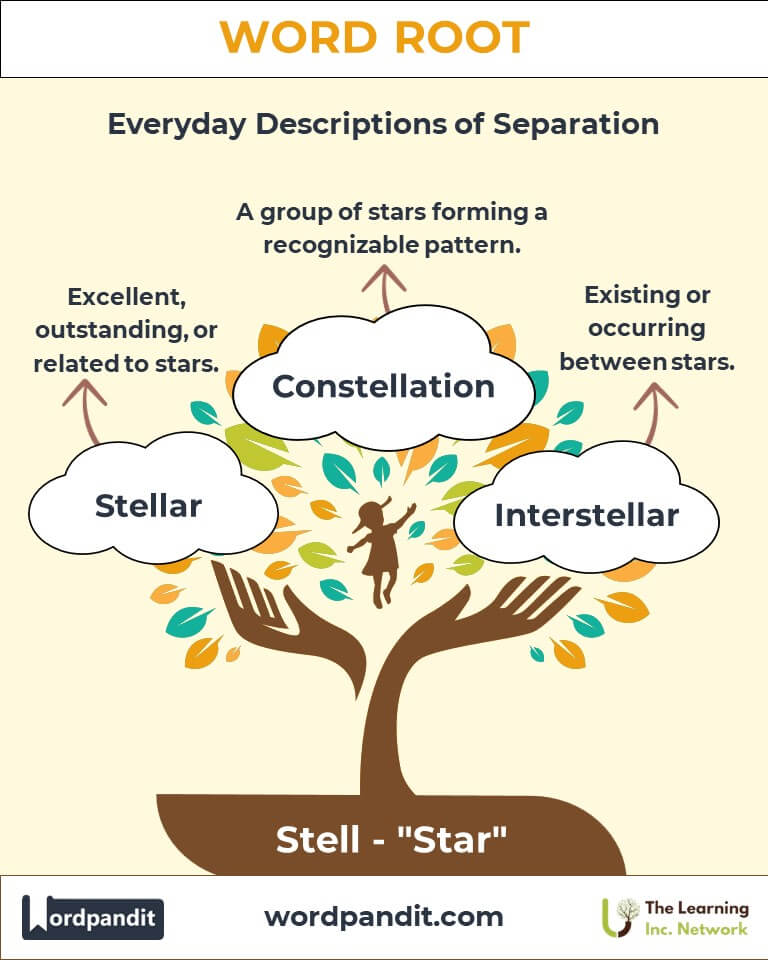Stell: Illuminating the Power of Stars in Language and Life
Discover the celestial charm of the root "stell," derived from the Latin stella, meaning "star." From radiant words like "stellar" to the cosmic imagery of "constellation," this root connects us to the wonders of the universe and humanity’s fascination with the stars.

Table of Contents
- Introduction: The Essence of "Stell"
- Etymology and Historical Journey
- Mnemonic: Unlocking the Power of "Stell"
- Common "Stell"-Related Terms
- "Stell" Through Time
- "Stell" in Specialized Fields
- Illustrative Story: "Stell" in Action
- Cultural Significance of "Stell"
- The "Stell" Family Tree
- FAQs About the "Stell" Word Root
- Test Your Knowledge: "Stell" Word Root Quiz
- Conclusion: The Living Legacy of "Stell"
Introduction: The Essence of "Stell"
What do a "stellar performance" and the mesmerizing patterns of a "constellation" have in common? They both derive their brilliance from the Latin root "stell", meaning "star." Pronounced as stel, this root shines across multiple languages and disciplines, symbolizing excellence, radiance, and the cosmos. Words rooted in "stell" often evoke imagery of the night sky or metaphorically describe something outstanding and exceptional.

Etymology and Historical Journey
The root "stell" originates from the Latin word stella (star). Early civilizations gazed at the night sky, mapping constellations and attributing divine significance to stars. As Roman culture evolved, stella became a poetic symbol of aspiration, guidance, and beauty. The root later found its way into English and other languages, enriching scientific and literary vocabularies alike.
Mnemonic: Unlocking the Power of "Stell"
To remember "stell," visualize a bright star shooting across the sky, leaving a trail that spells out the word.
Mnemonic Device:
"Stell is the star that lights up words like 'stellar' and 'constellation.'"
Common "Stell"-Related Terms
- Stellar (stel-er): Excellent, outstanding, or related to stars.
Example: "Her stellar performance earned her a standing ovation." - Constellation (kon-stuh-lay-shun): A group of stars forming a recognizable pattern.
Example: "Orion is one of the most well-known constellations in the night sky." - Interstellar (in-ter-stel-er): Existing or occurring between stars.
Example: "The spacecraft embarked on an interstellar journey to explore distant galaxies." - Stelliform (stel-i-form): Star-shaped.
Example: "The artist created a stelliform design that dazzled the crowd." - Stellate (stel-eyt): Resembling a star in shape.
Example: "The coral had a stellate structure, making it a rare find."
"Stell" Through Time
- Stella: Originally a Latin term for "star," it evolved into a popular name, symbolizing brilliance and beauty.
- Constellation: In ancient times, constellations were used for navigation and storytelling. Today, they serve as a foundation for modern astronomy.
- Stellar: Initially used to describe stars, this term later gained metaphorical significance, denoting excellence and superiority.
"Stell" in Specialized Fields
- Astronomy:
Interstellar: Refers to the space between stars, critical in understanding galactic structures.
Constellation: Essential for celestial navigation and mapping. - Design and Art:
Stelliform: Star-shaped patterns are popular in decorative arts and architecture. - Science and Medicine:
Stellate cells: Found in biology, these cells have a star-like appearance and play crucial roles in organ function. - Pop Culture:
Stellar achievements: Widely recognized as hallmarks of excellence.
Illustrative Story: "Stell" in Action
Amara loved stargazing with her grandfather, who taught her the names of constellations. Inspired by the stellar tales of Orion and Cassiopeia, Amara pursued a career in astronomy. One night, she discovered a new stelliform nebula, which she named after her grandfather. This discovery not only cemented her legacy in the scientific community but also highlighted the enduring beauty of the stars.
Cultural Significance of "Stell"
Stars have fascinated humanity for millennia. Ancient cultures used constellations for navigation and myth-making, seeing stars as divine messengers. Today, the root "stell" continues to symbolize brilliance and aspiration, appearing in everything from literature to motivational speeches. Stars remind us of our place in the universe and inspire dreams of reaching beyond.

The "Stell" Family Tree
- Astro- (Greek: "star"):
Astronomy: The study of celestial objects.
Astrology: The interpretation of celestial influence on human lives. - Lumin- (Latin: "light"):
Illuminate: To light up.
Luminary: A person who inspires or influences others. - Cosm- (Greek: "universe"):
Cosmos: The universe as an orderly system.
Cosmopolitan: Familiar with and at ease in many cultures.

FAQs About " Stell "
Q: What do the roots "sta" and "stat" mean?
A: The roots "sta" and "stat" come from the Latin word stare, meaning "to stand." They signify stability, position, or condition. These roots are foundational for words that describe standing firm, stillness, or a fixed state, such as "stationary" (not moving) and "statue" (a figure standing still).
Q: How are "sta" and "stat" used in science?
A: In science, these roots are integral to terms like "static" (unchanging or at rest) and "homeostasis" (the body's ability to maintain stable internal conditions). They capture concepts of equilibrium and balance, vital in physics, biology, and medicine.
Q: What is the origin of the word "station"?
A: The word "station" comes from the Latin statio, meaning "a standing place" or "a post." Originally referring to a specific location where someone or something stands, it now includes meanings like a transportation hub (e.g., a train station) or a role (e.g., a military station).
Q: What does "stasis" mean in different contexts?
A: "Stasis" refers to a state of balance, stillness, or inactivity. In medicine, it describes the cessation of normal fluid flow (e.g., blood or lymph). In history or politics, it can mean a standstill or period of inactivity, often during conflicts or negotiations.
Q: Are "status" and "statue" related?
A: Yes, both words derive from the Latin stare. "Status" refers to a person's standing or condition, whether social, legal, or professional. "Statue," on the other hand, refers to a figure that literally stands, often symbolizing a concept, person, or idea.
Q: What does "static electricity" mean?
A: "Static electricity" refers to the accumulation of electric charge on a surface that is not moving or flowing. The word "static" here captures the root’s meaning of "still" or "unchanging," as the charge remains in one place rather than moving like current electricity.
Test Your Knowledge: " Stell " Mastery Quiz
1. What does the root "stat" mean?
2. Which term describes data analysis?
3. What is "stasis"?
4. What does "stationary" mean?
5. What root relates to equilibrium in medicine?
Conclusion: The Everlasting Glow of "Stell"
The root "stell" connects us to the beauty and brilliance of the stars, influencing language, science, and culture. From ancient myths to modern discoveries, its legacy endures as a symbol of aspiration and excellence. Explore the world of "stell" and let its radiance inspire you to reach for the stars.












